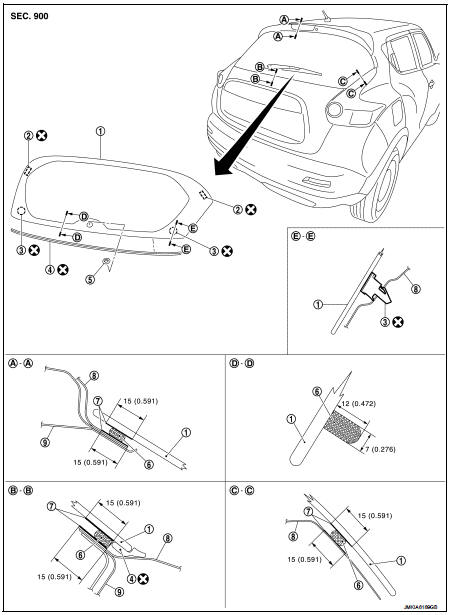Nissan Juke Service and Repair Manual : Back door window glass
Exploded View

1. Back door window glass
2. Spacer
3. Back door window glass holder
4. Back door window glass molding
5. Pivot seal
6. Adhesive
7. Primer
8. Back door outer
9. Back door inner
Unit: mm (in)
 : Do not reuse
: Do not reuse
Removal and Installation
REMOVAL
1. Remove back door lower finisher. Refer to INT-35, "BACK DOOR LOWER FINISHER : Removal and Installation".
2. Remove back door side finisher (LH and RH). Refer to INT-35, "BACK DOOR SIDE FINISHER : Removal and Installation".
3. Remove rear wiper motor. Refer to WW-86, "Removal and Installation".
4. Remove the connectors and grounds for the back door window defogger.
5. Remove glass using piano wire or power cutting tool (A) and an inflatable pump bag (B) after removing molding using pliers.

NOTE
:
Mark the body and glass with a matching marks if the back door window is reused.
WARNING:
Always wear safety glasses and heavy gloves to help prevent injuries.
CAUTION:
• Never use a cutting knife or power cutting tool when the back door window
glass is reused.
• Be careful not to scratch the glass when removing.
• Never set or stand the glass on its edge. Small chips may develop into cracks.
INSTALLATION
• The dam sealant rubber should be installed in position.
• Use a Genuine Nissan Urethane Adhesive Kit (if available) or an equivalent and follow the instructions provided with it.
• Open a door window while the urethane adhesive is curing. This prevents the glass from being forced out by passenger compartment air pressure when all door windows are closed.
• The molding must be installed securely so that it is in position and leaves no clearance.
• Inform the customer that the vehicle should remain stationary until the urethane adhesive is completely cured (approximately 24 hours). Curing time varies with temperature and humidity.
WARNING:
• Keep heat and open flames away as primers and adhesive are flammable.
• The materials contained in the kit are harmful if swallowed, and may irritate skin and eyes. Never let them come in contact with the skin and eyes.
• Use in an open, well ventilated location. Never breathe the vapors. They may be harmful if inhaled. Move immediately to an area with fresh air if affected by vapor inhalation.
• Driving the vehicle before the urethane adhesive is completely cured may affect the performance of the back door window in an accident.
CAUTION:
• Perform adjustment of rear wiper arm stop location. Refer to WW-84,
"Adjustment".
• Never use an adhesive that is past its usable term. Shelf life of this product is limited to six months after the date of manufacture. Adhere carefully to the expiration or manufacture date printed on the box.
• Keep primers and adhesive in a cool, dry place. Ideally, they should be stored in a refrigerator.
• Never leave primers or adhesive cartridge unattended with their caps open or off.
• The vehicle should not be driven for 24 hours or more or until the urethane adhesive is completely cured. Curing time varies depending on temperature and humidity. The curing time increases under lower temperature and lower humidity.
Inspection
REPAIRING WATER LEAKAGE FOR BACK DOOR WINDOW GLASS
Leakage can be repaired without removing the glass.
Determine the extent of leakage if water is leaking between the urethane adhesive material and body or glass.
This can be done by applying water to the back door window glass area while pushing glass outward.
Apply primer (if necessary) and then urethane adhesive to the leakage point to stop the leakage.
 Windshield glass
Windshield glass
Exploded View
1. Windshield glass molding
2. Dam rubber (upper)
3. Upper clip
4. Windshield glass
5. Dam rubber (lower)
6. Lower clip
7. Mirror base
8. Rain sensor bracket
9. Adhesive ...
 Front door glass
Front door glass
Exploded View
1. Front door panel
2. Lower sash (front)
3. Sealing screen
4. Pull handle bracket
5. Front door glass run
6. Front door glass
7. Power window motor
8. Front door regulato ...
Other materials:
IGN off interlock door unlock function does not operate
Diagnosis Procedure
1.CHECK “AUTOMATIC LOCK/UNLOCK SELECT” SETTING IN “WORK SUPPORT”
1. Select “DOOR LOCK” of “BCM” using CONSULT-III.
2. Select “AUTOMATIC LOCK/UNLOCK SELECT” in “WORK SUPPORT” mode.
3. Check “AUTOMATIC LOCK/UNLOCK SELECT” in “WORK SUPPORT”.
Refer to DLK-41, "DOOR LOCK : ...
System
CVT control system : System Diagram
CVT control system : System Description
INPUT/OUTPUT SIGNAL TABLE
*: With Nissan Dynamic Control System
SYSTEM DESCRIPTION
• CVT detects the vehicle driving status from switches, sensors and signals,
and controls the vehicle so that
the optimum shift p ...
System
System Diagram
System Description
DESCRIPTION
• Manual air conditioning system is controlled by each function of thermo
control amp., BCM, ECM and IPDM
E/R.
• Fan speed of blower motor is changed by the combination of fan control dial
operation and blower fan resistor
control.
CONTROL ...
